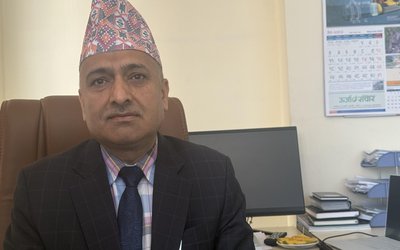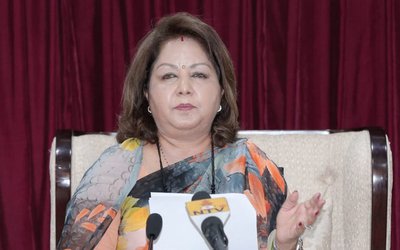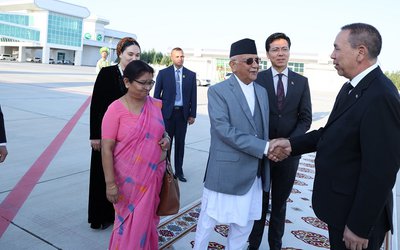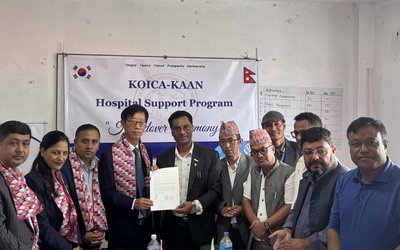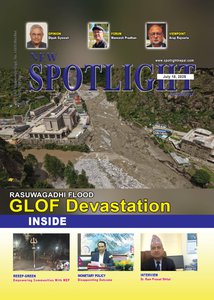
What is your perspective on Nepal's recent submission of its Nationally Determined Contribution (NDC) in line with its commitment to achieve net-zero carbon emissions by 2050 as a party to the UNFCCC and signatory of the Paris Agreement?
Nepal has developed key policy instruments such as the National Climate Change Policy and the National Adaptation Plan, and now the third NDC. The submission of NDC 3.0 ahead of the deadline set by the UNFCCC for February 2025 reflects Nepal's proactive approach towards climate action.
Why is timely submission of the NDC important?
Nepal, known for its biodiversity, forest cover, and organic agricultural practices, aims to balance development with environmental sustainability. The country plans to conserve forests to offset carbon emissions and transition to clean energy sources like hydropower to maintain a low-emission trajectory. As Nepal industrializes, it plans to decarbonize by phasing out coal and fossil fuels in favor of clean energy alternatives. Nature-based and ecosystem-based solutions will also be implemented to sequester carbon and achieve net-zero emissions by 2045.
How is Nepal's current energy consumption assessed, considering its population and rural areas?
Nepal's energy consumption is relatively low, but with industrialization on the rise, there is a need for increased focus on climate-friendly initiatives. The country aims to increase its climate-focused budget from 6% to 20% in the next five years. Strong policy instruments are in place, but institutional reform and resource mobilization are necessary for effective implementation. Nepal has submitted NDC 3.0 ahead of the deadline, showcasing its commitment to climate action.
Nepal aims to achieve net-zero emissions by 2045 and to cover over 200 municipalities with Municipal Energy and Energy Efficiency Plans. How do you view the current state of the energy transition?
The country's NDC 3.0 outlines strategies to reduce greenhouse gas emissions, transition to green energy, and adapt to climate change impacts. These efforts align with the long-term goals of the Paris Agreement, including peaking global emissions and achieving a balance between emissions and removals.
How is Nepal's current energy consumption assessed?
With a population of around 30 million, mostly in rural areas, Nepal's energy consumption is currently low but expected to increase with industrialization. The country has five more five-year development plans ahead, with the current plan emphasizing a climate-friendly budget. Currently, only 6% of the budget is climate-focused, but the goal is to increase this to 20% in the next five years. Nepal has strong policy instruments in place, but institutional reform and increased resource mobilization are needed for effective implementation of climate-resilient programs. Nepal has submitted its NDC 3.0 under the Paris Agreement, fulfilling its commitment ahead of the deadline.
Nepal is committed to achieving net-zero emissions by 2045 and implementing Municipal Energy and Energy Efficiency Plans in over 200 municipalities under NDC 3.0. How do you assess the progress of the energy transition in Nepal?
Nepal's NDC 3.0 outlines strategies to reduce greenhouse gas emissions by transitioning to green energy and adapting to climate change impacts. It is crucial for meeting the Paris Agreement's goals of peaking global emissions and achieving emission balance. The NDC includes various strategies to reach these targets. Nepal's NDC 3.0 is the country's third set of climate goals under the Paris Agreement. It focuses on ambitious targets for energy transition and emission reduction, considering Nepal's vulnerabilities as a Least Developed Country and a Himalayan nation. The plan depends on international support for implementation.
How do you evaluate the bill's contribution to achieving NDC 3.0 goals?
Following the recent submission of NDC 3.0, the Upper House has passed the Bill Relating to Renewable Energy and Energy Efficiency, 2081, which is now under consideration in the House of Representatives. As an expert involved in the discussions, one key point of debate has been the classification of clean energy sources. While solar, hydro, and wind energy are considered clean, there is ongoing discussion about the environmental and social impacts of hydropower. The focus is on striking a balance between the benefits of clean energy generation and the potential costs associated with hydropower development.

What is the contribution of hydropower in Nepal?
Hydropower is major sources of clean electricity in Nepal. In Nepal, there is no official definition of green hydropower capacity. The Green Climate Fund supports projects up to 40 MW, but I believe even a 1,000 MW project should be considered clean due to its lower environmental impact compared to fossil fuels. Nepal's snow-fed rivers and fresh water are essential for hydropower and climate resilience.
How the Renewable Energy and Energy Efficiency Bill will contribute to clean energy?
The Renewable Energy and Energy Efficiency Bill, once passed by the lower house, will empower the Alternative Energy Promotion Center (AEPC) to regulate carbon trading, establish energy efficiency standards, and promote renewable energy sources in Nepal. This legislation will encourage private investment in renewable energy and energy efficiency projects, supporting climate policies and economic development. It will help Nepal transition to a climate-resilient economy by mobilizing resources and creating a favorable environment for sustainable growth.
Private sector players are keen to engage in the global carbon market. What is the current status of carbon trading regulations in Nepal?
The Environment Protection Act in Nepal already permits private sector involvement in carbon trading. Since taking on this role, I have focused on finalizing the regulations. Following multiple rounds of discussions, our ministry has developed the Carbon Trade Regulations and submitted them to the Ministry of Law for legal scrutiny. The draft regulation outlines three participant categories in carbon trading: government-to-government (G2G), government institutions, and the private sector. This regulation will enable all sectors - government, private, and non-governmental - to partake in carbon trading.
When can we expect the regulations to be released?
Upon receiving the legal assessment from the Ministry of Law, the regulation will be presented to the Cabinet for approval. Once approved by the Cabinet, we will expedite private sector involvement in the carbon market. The legal basis for carbon trading is provided by Article 6 of the Paris Agreement. Specifically, Article 6.2 addresses G2G trade, while Article 6.4 allows for private sector engagement through fair competition. We are also advocating for the opening of Nepal's domestic carbon market to private entities. For example, companies such as Buddha Air, Yeti Airlines, or other transportation and industrial firms could acquire carbon credits to offset their emissions and declare themselves carbon-neutral. This initiative will support Nepal's objective of achieving carbon neutrality.
What is your perspective on private sector involvement in carbon trading?
Nepal, being one of the most climate-vulnerable countries, requires substantial funding for climate resilience. Carbon trading offers a valuable opportunity to attract international finance to support Nepal's development. However, current regulations are insufficient to fully facilitate this process. Therefore, we are introducing a comprehensive regulation to support private sector participation, which I believe will address existing barriers and expand the carbon market's reach.
In recent years, infrastructure, including hydropower projects, has suffered significant damage from extreme rainfall and glacier lake outburst floods (GLOFs). You recently participated in a high-level meeting on Loss and Damage. What are the chances of receiving compensation?
The Loss and Damage Fund, aimed at global-scale climate disaster response, shows promise. One crucial aspect is determining the available global funding and how much Nepal can realistically access. To build a strong case, we must gather accurate evidence and data on the extent of the damage incurred.
Private sector actors, such as the Independent Power Producers’ Association Nepal (IPPAN), are also interested in accessing the Loss and Damage Fund. How likely is it for them to receive compensation?
While we often attribute glacier melting and GLOFs to climate change and seek compensation accordingly, we must also carefully consider whether some floods are a result of human activities. For example, infrastructure is frequently constructed without proper Environmental Impact Assessments (EIA), and unregulated road building has triggered landslides and flash floods. Nepal's geographical location makes it naturally susceptible to extreme rainfall and related disasters. In recent years, we have observed unprecedented rainfall events, some of which have exceeded 100-year records. This shifting climate pattern makes Nepal eligible to seek compensation through the Loss and Damage mechanism. Our current focus is on the changing temperatures in the Himalayas and the increasingly unpredictable rainfall, both of which increase the risk of floods. Incidents like the Melamchi flood and the recent Rasuwagadhi floods illustrate how interconnected disasters can cause significant damage to vital infrastructure.
What should Nepal focus on in the future?
Moving forward, Nepal should prioritize strengthening early warning systems and implementing water siphoning techniques from upstream glacier-fed rivers. In downstream areas, infrastructure should be designed to be flood-resilient. By reducing risks through preparedness and resilient development, Nepal can qualify for support from the Loss and Damage Fund, which currently holds around USD 700 million. Advocacy efforts are underway to release at least USD 250 million on a fast-track basis for countries affected by extreme weather. Drafting of relevant regulations is in the final stages, and once approved by the fund’s governing body, the fund disbursement process will commence. Calls for project proposals will also be issued, necessitating the building of national capacity.
You previously led this division during a transitional period four years ago and are now leading it again. How do you evaluate Nepal’s current position?
Nepal has made significant progress in developing strong policies and programs to address climate change over the years. Despite global funding limitations, development partners such as the European Union and the German government continue to support Nepal in clean energy and climate resilience. However, Nepal still faces challenges in accessing international climate finance on a larger scale. To address this, Nepal must enhance institutional capacity, reform regulatory frameworks, and mobilize domestic and international resources more effectively to achieve its climate goals.
- Diplomatic Efforts On For Search, Rescue Of Nepalis Missing In Uttarakhand Floods: Minister Rana
- Aug 08, 2025
- PM Oli Expresses Sorrow Over Flood-Triggered Loss In Uttarakhand, India
- Aug 08, 2025
- Prime Minister Oli To Return Home Today
- Aug 08, 2025
- Monsoon's Influence To Prevail Across The Country Today
- Aug 08, 2025
- KOICA-KAAN Supported Primary Hospital, Thankot Worth NPR 14,04,895
- Aug 07, 2025

